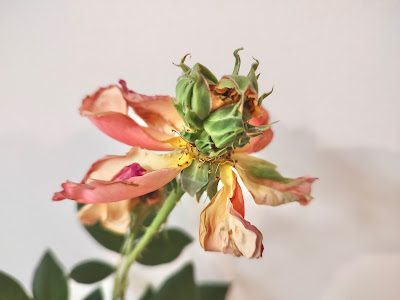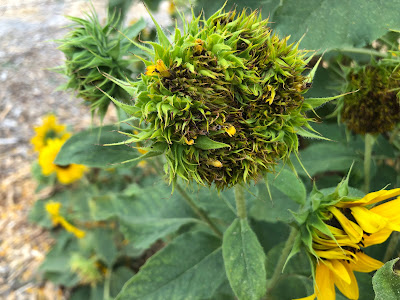
Hormone imbalance and heat fluctuations linked to deformed flowers

|
|
This About Face grandiflora rose is displaying
fasciation in its spent bloom. (Photo: Debbie
Arrington)
|
They look like something out of “Little Shop of Horrors”: Weirdly distorted buds that sprout out of the center of a spent rose. And this summer, more seem to be popping up on rose bushes throughout Sacramento – as well as other plants.
It’s another garden oddity likely tied to extreme fluctuations in temperature: Fasciation.
This phenomenon – strange, unexpected growth of terminal buds – is a genetic mutation of a plant’s growing tip. It’s believed to be triggered by a hormone imbalance that may be caused by outside factors such as roller-coaster temperatures or exposure to herbicides (such as Roundup).
I can’t help it; I’m fascinated by fasciation. In roses, it looks like a whole spray of monstrous buds is trying to wiggle out of the center of a bloom – often before the first flower has dropped its petals.
I have one hybrid tea – Perfect Moment – that always seems to display some fasciation in the heat of summer (and it did). But this August, I’m also seeing fasciation on bushes that never showed it before. That includes About Face, a very tall grandiflora; this week, several of its spent blooms sprouted the weird deformed buds.
The roses were not exposed to Roundup or other chemicals; it had to be the heat.
The good news: It’s not contagious. Snip off the weird flower and the plant will (fingers crossed) grow a “normal” bud.

|
|
Fasciation also can show up in sunflowers. This was a
bloom that exhibited some weird extra growth. (Photo: Kathy
Morrison)
|
In strawberries, fasciation creates giant double or triple berries. The cockscomb celosia – with flowers that look like rooster heads – are a result of fasciation.
Heirloom tomatoes – particularly those with ugly bottoms – are believed to be another case of fasciation as a desirable trait.
Fasciation also can produce flat, fused stems or tufts of fused growth, often referred to as “witches’ broom.” Besides heat and herbicides, fasciation may be caused by bacteria, in particular Rhodococcus fascians , say UC master gardeners.
For more on fasciation: http://ipm.ucanr.edu/PMG/GARDEN/FLOWERS/DISEASE/fasciation.html
Comments
0 comments have been posted.Sacramento Digs Gardening to your inbox.
Sites We Like
Garden Checklist for week of May 5
Survey your garden after the May 4 rainstorm. Heavy rain and gusty winds can break the neck of large flowers such as roses. Also:
* Keep an eye on new transplants or seedlings; they could take a pounding from the rain.
* Watch out for powdery mildew. Warmth following moist conditions can cause this fungal disease to “bloom,” too. If you see a leaf that looks like it’s dusted with powdered sugar, snip it off.
* After the storm, start setting out tomato transplants, but wait on the peppers and eggplants (they want warmer nights). Pinch off any flowers on new transplants to make them concentrate on establishing roots instead of setting premature fruit.
* Trim dead flowers but not leaves from spring-flowering bulbs such as daffodils and tulips. Those leaves gather energy to create next year's flowers. Also, give the bulbs a fertilizer boost after bloom.
* Pinch chrysanthemums back to 12 inches for fall flowers. Cut old stems to the ground.
* Mulch around plants to conserve moisture and control weeds.
* From seed, plant beans, beets, cantaloupes, carrots, corn, cucumbers, melons, pumpkins, radishes and squash.
* Plant onion sets.
* In the flower garden, plant seeds for asters, cosmos, celosia, marigolds, salvia, sunflowers and zinnias. Transplant petunias, zinnias, geraniums and other summer bloomers.
* Plant perennials and dahlia tubers for summer bloom.
* Don’t wait; plant summer bulbs, such as gladiolus and tuberous begonias.
* Harvest cabbage, lettuce, peas and green onions.